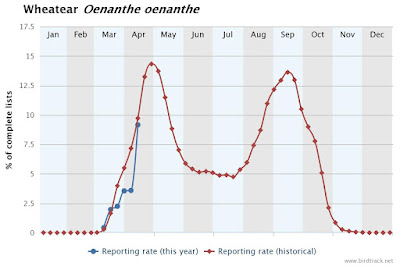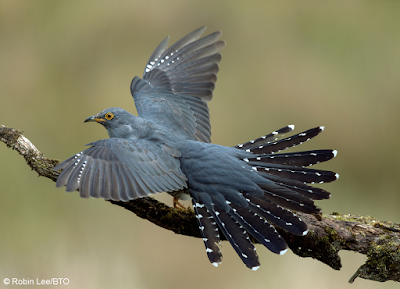The nature of migration generally this spring
has been one of sudden flurries followed by slow trickles. This week continued
along much the same lines: a glorious weekend with a southerly airflow and wide
isobars saw the floodgates open for northbound migrants to stream into the
country. Coastal localities were inundated with Willow Warblers, Blackcaps and
Wheatears, and species like Redstart, Sedge Warbler, Whitethroat, Ring Ouzel
and Grasshopper Warbler took advantage of the passing weather front to move in
from the continent. Then the traffic lights turned red: a complete flip in the airflow
saw bitter northerly winds dominating for much of the week; temperatures
plummeted into the single figures and flurries of snow and hail across the
north of the UK further added to the week’s wintry feel.
 |
| Willow Warbler by Ben Porter |
The calm conditions over the weekend made
for some great arrivals here on Bardsey: bushes were brimming with Willow Warblers
and Blackcaps; Grasshopper Warblers sent out reeling songs from the damper
wetlands; Swallows and Sand Martins zipped northward overhead; and seemingly
every grassy knoll and bank was topped with a Wheatear! Greenland-race
Wheatears have been one of the dominating migrants on the island this week,
their larger size and deeper orange belly contrasting with a flash of white as
they alight with hard ‘chacking’
calls. An excellent arrival saw over 250 birds on the 20th, although the
national reporting rate on Birdtrack still shows below-average occurrence. It
looks like the pressure front next week is going to help these leucorhoa birds make their long-distance
flights to the Arctic tundra via Iceland and Greenland.
 |
| Wheatears by Ben Porter |
Cuckoos and Turtle Doves have yet to make
it over the Irish Sea to the island, although both species reached Scotland
this week, with a Turtle Dove on the isle of Rhum and a Cuckoo in Lothian!
Three of the BTO’s satellite-tagged Cuckoos are now north of the Pyrenees and
should make the home stretch to join ‘Selborne’ with a brisk south-east
tailwind in the next week. Keep up to date with their movements here
A smattering of colourful scarcities
arrived in the UK this week, including Golden Oriole, multiple Hoopoes, at
least three Bee-Eaters (one of which even paid London a visit!), White-spotted
Bluethroats, Serin, Red-footed Falcons and the spring’s first Savi’s Warbler.
We can expect to see plenty more of these overshooting continentals as we enter
May, plus some non-passerine visitors such as Temminck’s Stints on inland
reservoirs. Conversely, Waxwing numbers are likely to dwindle as birds continue
to dissipate north-east – we still had around 600 birds in the country last
week, although they were absent from Ireland, Wales and the South-west.
Whimbrels should arrive in earnest over the
next ten days as we approach their peak spring reporting period. The numbers
here on Bardsey Island are still below-average for the time of year. Contrast
that to the national picture, and the reporting rate is slightly above the historical
average, fast-approaching 7.5% of Birdtrack user’s lists. Keep an eye out for
colour-ringed birds amongst migrating flocks: they are most likely to be from
Iceland, but a few sites in the UK also carry out colour-ringing on these
waders, including Bardsey Bird Observatory.
Make sure you report colour-ring sightings and email the Iceland project (icelandwader@gmail.com)
should you see any. It’s through anaylsis of ringing recoveries and recent
satellite tracking that has revealed some impressive autumn
movements of Icelandic Whimbrels from Iceland to North Africa. It’s also
indicated that most birds on the east coast – both in spring and autumn – are
likely to be Scandinavian.
 |
| Whimbrel ring recoveries from BTO. Whimbrel images by Ben Porter |
Early May is one of the best times of year
to catch up with trips of Dotterels as they touch down on hill tops and coastal
spots en route to their breeding
grounds. A scattering of birds have already been seen over the last week,
including at favoured sites such as the Great Orme in North Wales. Lancashire’s
Pendle Hill will no doubt host a few of these superb waders in the next few days.
So what of the week to come? A low-pressure
system rolling in from the Atlantic over Saturday and Sunday will see the
strong winds switching around to the south-east, which could provide the
encouragement needed for migrants to move up through France and continue
northwards in the UK. A widening of isobars and an area of high pressure over
France and Iberia in the earlier part of the week should make for a good
arrival of more warblers, chats and waders. Temperatures should climb a little
higher too, which will hopefully encourage the invertebrate life to emerge and
provide weary migrants with much-needed refueling!
 |
| Low pressure is due to arrive on Saturday - image from Met Office. |
We’ve almost welcomed back the full
complement of spring migrants as far as songbirds are concerned, although Spotted Flycatchers have yet to appear, and the peak arrivals of Wood Warblers,
Pied Flycatchers, Yellow Wagtails, Garden Warblers and Lesser Whitethroats will
probably occur over the next week or two given the promising outlook.
 |
| Spotted Flycatcher by Ben Porter |
If you’re heading out over the weekend,
listen out for the liquid gold song of the Nightingale – birds should be back
on breeding territories very soon. The bright sunny weather forecast for early
next week will be perfect for Common Swifts to scythe their way overhead in
screaming flocks. If you haven’t already, why not consider fitting a Swift
nestbox to your house? There is just enough time before they return! There are
plenty of tips at www.swift-conservation.org.
The reporting rate for Common Tern and Arctic
Tern is on the increase, and the strong winds this weekend might make
seawatching a productive option to spot flocks passing by. You might also be in
with a chance of seeing Pomarine, Arctic and Great Skuas passing the coast.
Rarities in the coming week could take the form of more overshooting
continental migrants such as Black-Winged Stilts and Golden Orioles, although
the south-easterly wind might favour perhaps a Collared Flycatcher, Citrine
Wagtail or Red-throated Pipit even on the east coast.
 |
| Red-throated Pipit by Ben Porter |










